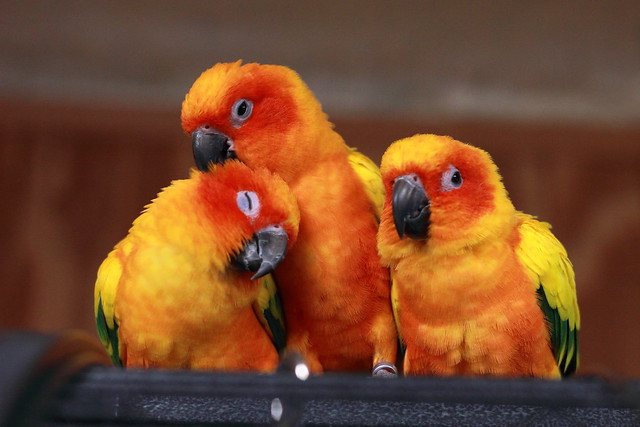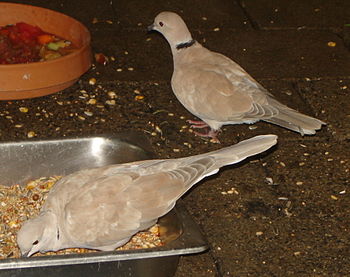 |
| Determining the bird's characteristics like sex, age, and physical condition (Photo credit: Wikipedia) |
1. WARMTH:
Ill birds will sit with their feathers fluffed in an attempt to conserve heat. The effort to conserve heat places an additional burden on the already debilitated bird. Your veterinarian will determine if your bird requires hospitalization, but if home care is acceptable, I recommend creating a tent to keep your bird warm. A bird's natural temperature is much higher than ours at anywhere from 103F-106F. Therefore, what often feels warm to us can be chilly to them and this is particularly true in sick birds. A simple way of providing heat is to cover 1/2 of the cage with a blanket and place a heat lamp on the other side as a heat source. Generally speaking, we keep our sick birds at environmental temperatures ranging from 85-95F. This will vary greatly with the individual bird so it is important to monitor your pet to ensure that you are providing the correct temperature and of course seek your veterinarian's advice.
A bird that is too hot will have very sleek feathers held tightly to the body, will hold its wings (shoulders) slightly away from its body and may pant. If you see any of these signs your bird is much too warm and the environmental temperature should be reduced accordingly. For night warmth I recommend using a red light. Ill birds, just like ill people, require rest and if kept under bright lights all night they will become sleep deprived. Also, during the day it is important to provide light so that they may be encouraged to eat and can be monitored. Therefore, the entire cage should never be covered during the day. I don't recommend heating pads because it is very difficult to regulate the temperature. If a bird is not perching and sitting directly on the pad they can easily become overheated or burned. And in my experience baby birds that are raised on heating pad quickly become dehydrated and again are subject to burns.
2. STRESS:
Debilitated birds must be kept in a stress-free situation. Often what appears normal to us can cause stress in our feathered friends. I suggest taking a close look at your bird's environment with a critical eye to determine what may be stress factors. Some common ones include, the bird in the center of house traffic with no chance to rest, cigarette smoke or aerosols in the birds environment, lack of darkness/sleep time at night, other pets, small children, too much visual stimuli (cage directly in front of a window), competition from cage mates, too much handling, poor nutrition and temperature extremes (such as birds kept in kitchens). I recommend that sick birds be left in their cage and allowed to calmly recuperate.
Think of this as bed rest for your pet! Too much handling can stress the bird and will require the bird to use additional calories. If the bird is housed with other birds, it is usually best to remove the bird to a single cage. Some birds can become too stressed when separated from the colony so you should seek your veterinarian's advice on how to cage your sick pet. However, generally removing the bird from the group will reduce the stress of competition for nutrition and allow for medicating easily and better monitoring. Of course, if an infectious disease is suspected, then the pet must be moved into an isolation cage and at least a separate room - preferably a separate house with no other birds.
3. NUTRITION:
If your doctor made dietary recommendations, now is not the time to implement change. Changes in the type of diet will cause enormous stress to your bird and should be started when the bird has recovered. Always discuss how and when to made dietary changes with your pet's doctor. Generally, I recommend offering all the bird's favorite foods during illness because many ill birds become anorexic and can be lost due to starvation. If your bird is normally a seedeater but not currently eating, try placing millets sprays in the cage which most birds enjoy. The important thing to remember is that it has taken months to years for the bird to become malnourished and this cannot be corrected in a day or a week. Slow changes are essential for the ill bird. If you are unable to get your pet to eat he/she should be hospitalized for gavage feeding and further care. Birds have a high metabolic rate and can quickly starve.
Thus, a pet bird that stops eating should always be assumed to be critically ill, certainly, the potential for fatality is present. Lastly, if your bird is a hand reared baby and is not eating due to illness, you can often revert them back to hand feeding (syringe feeding) during the convalescent period. A good hand rearing formula should be used. The formula should be mixed with hot water as directed on the bag and offered to the bird. Do not force the bird to eat. Pet owners should never force feed their birds. A bird can easily aspirate (inhale food) and develop pneumonia and force-feeding causes enormous stress to your bird. Reverting to hand feeding is only of use for those birds that willingly accept feeding on the syringe. Also, if hand feeding, the formula must be warmed correctly (follow the advice on the formula bag and that of your veterinarian) to avoid food burns from too hot formula and crop stasis from formula fed at too cool a temperature.
4. MEDICATING:
Routes:
1. Injectable,
2. In water or Food,
3. Topical,
4. Oral
I prefer not to medicate in the pet's water or the food. Medication is given in this way often causes a change in the taste and can potentially cause the bird to reduce their food and water intake. Also, when medication is placed in the food or water it is very difficult to determine how much of the medication the pet has actually ingested. Thus, in my opinion, the best routes are injectable and oral. Topical medication often is not of use to the pet and will cause oily feathers.
Prior to taking your bird home, you should be shown how to appropriately medicate your bird by the doctor or technician. Briefly, the patient should be held in an upright position and the syringe containing the medication should be gently introduced from the left side of the mouth and angled to the right side. Most birds will attempt to bite the syringe allowing it to be easily introduced into the oral cavity. Slowly depress the plunger on the syringe to dispense the medication into the lower portion of the beak. If the pet struggles while medicating, stop for a few moments and then try again. You should advise your veterinarian if you are unable to medicate your pet. Medication can be mixed with a flavoring agent (FlavorX), which will help to reduce some resistance. Occasionally, depending on the reason for treatment, your doctor may be able to give a long-acting injection in place of oral medication but this has limited uses and thus is not available for every pet.
5. FOLLOW-UP EXAMINATIONS:
As soon as the illness was detected in your pet he/she was taken to the veterinarian for a thorough physical examination and diagnostic workup including laboratory testing. Unfortunately, many people will see that their pet is improving and don't realize that a follow-up exam is necessary. I always suggest rechecking the patient at variable intervals depending on the state of debilitation. The recheck exam allows your doctor to assess the patient's response to treatment and the owner's compliance with instructions. Many times in the course of treating an exotic pet the treatment must be altered somewhat to ensure the best response. These rechecks are also used as a way of reinforcing the changes needed for the bird to remain healthy. Additionally, lab values can be rechecked to ensure that the patient is truly recovering and not just feeling well enough again to resume hiding any weakness. I can't stress the importance of this follow up enough, it is extremely important to the health of your bird.
Most importantly, follow the advice of your veterinarian and ask questions to ensure that you completely understand what is needed of you to get your pet back to health.
Jill M. Patt, DVM - Medical Director at Alta Mesa Animal Hospital Providing Small & Exotic Animal Pet Care in the Valley of the Sun (Mesa, AZ) http://www.littlecrittersvet.com - Pet Care Information & Photo Gallery Visit littlecrittersvet for extensive information on small & exotic pet care with > 1000 photos of animals from informative to just darn cute. http://www.altamesaanimalhospital.com - Alta Mesa Animal Hospital 6704 E. Brown Rd. Mesa, AZ 85205 (480) 981-1244 Article Source: EzineArticles |












